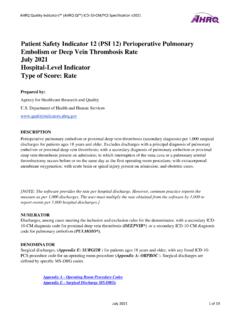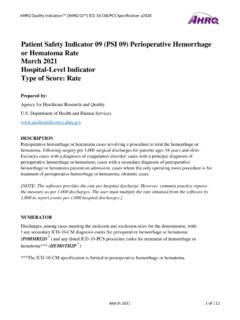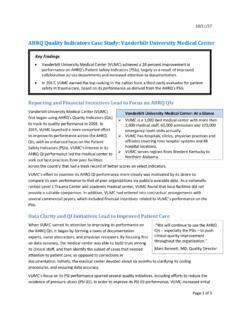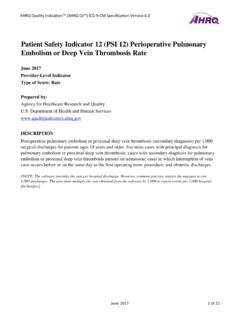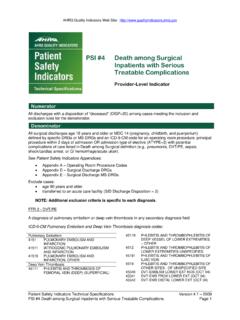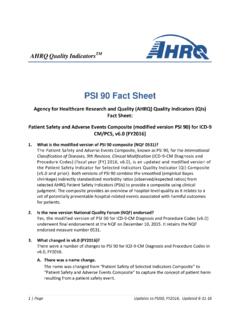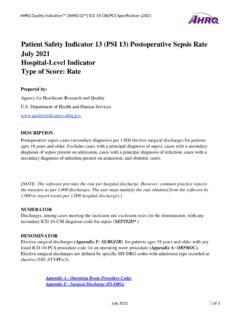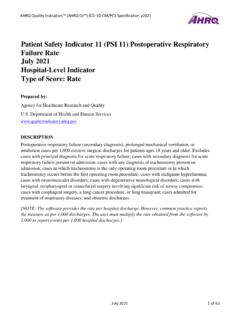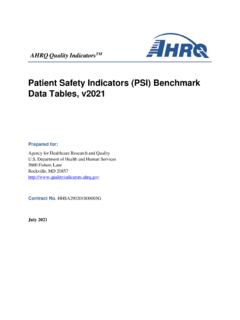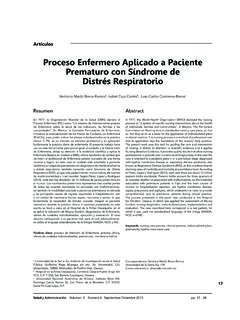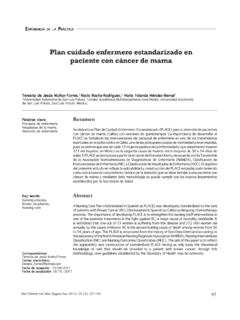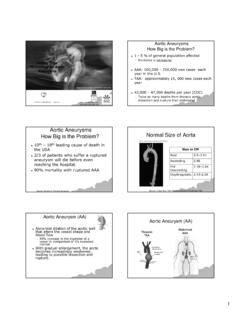Transcription of Patient Safety Indicators™ V2020 Benchmark Data Tables
1 AHRQ Quality IndicatorsTM Patient Safety INDICATORS V2020 Benchmark data Tables Prepared for: Agency for Healthcare Research and Quality Department of Health and Human Services 5600 Fishers Lane Rockville, MD 20857 Contract No. HHSA290201800003G Prepared by: Mathematica Box 2393 Princeton, NJ 08543-2393 July 2020
2 AH RQ Quali ty Indicators Patient Safety Indicators (PSI) Benchmark data Tables Contents 1 2 table 1. Patient Safety Indicators (PSI) for Overall Population: Hospital-Level table 2. PSI 02 Death Rate in Low-Mortality diagnosis Related Groups (DRGs), per 1,000 4 table 3. PSI 03 Pressure Ulcer Rate, per 1,000 Admissions .. 4 table 4. PSI 04 Death Rate among Surgical Inpatients with Serious Treatable Complications, per 1,000 table 5.
3 PSI 04 Death Rate among Surgical Inpatients with Serious Treatable Complications Stratum DVT PE, per 1,000 Admissions .. 5 table 6. PSI 04 Death Rate among Surgical Inpatients with Serious Treatable Complications Stratum Pneumonia, per 1,000 Admissions .. 6 table 7. PSI 04 Death Rate among Surgical Inpatients with Serious Treatable Complications Stratum Sepsis, per 1,000 table 8. PSI 04 Death Rate among Surgical Inpatients with Serious Treatable Complications Stratum Shock/Cardiac Arrest, per 1,000 7 table 9.
4 PSI 04 Death Rate among Surgical Inpatients with Serious Treatable Complications Stratum Gastrointestinal (GI) Hemorrhage/Acute Ulcer, per 1,000 Admissions .. 7 table 10. PSI 05 Retained Surgical Item or Unretrieved Device Fragment Count .. 8 table 11. PSI 06 Iatrogenic Pneumothorax Rate, per 1,000 Admissions .. 8 table 12. PSI 07 Central Venous Catheter-Related Blood Stream Infection Rate, per 1,000 9 table 13. PSI 08 In Hospital Fall with Hip Fracture Rate, per 1,000 Admissions .. 9 table 14.
5 PSI 09 Perioperative Hemorrhage or Hematoma Rate, per 1,000 Admissions .. 10 table 15. PSI 10 Postoperative Acute Kidney Injury Requiring Dialysis Rate, per 1,000 Admissions .. 10 table 16. PSI 11 Postoperative Respiratory Failure Rate, per 1,000 table 17. PSI 12 Perioperative Pulmonary Embolism or Deep Vein Thrombosis Rate, per 1,000 11 table 18. PSI 13 Postoperative Sepsis Rate, per 1,000 12 table 19. PSI 14 Postoperative Wound Dehiscence Rate, per 1,000 12 table 20. PSI 14 Postoperative Wound Dehiscence Rate Stratum: Open, per 1,000 Admissions.
6 13 table 21. PSI 14 Postoperative Wound Dehiscence Rate Stratum: Non-Open, per 1,000 Admissions .. 13 table 22. PSI 15 Abdominopelvic Accidental Puncture or Laceration Rate, per 1,000 14 Version V2020 Page i July 2020 AH RQ Quali ty Indicators Patient Safety Indicators (PSI) Benchmark data Tables table 23. PSI 18 Obstetric Trauma Rate Vaginal Delivery With Instrument, per 1,000 Admissions. 14 table 24. PSI 19 Obstetric Trauma Rate Vaginal Delivery Without Instrument, per 1,000 Admissions.
7 15 Version V2020 Page ii July 2020
8 AH RQ Quali ty Indicators Patient Safety Indicators (PSI) Benchmark data Tables Introduction The data presented in this document are nationwide comparative rates for Version 2020 of Agency for Healthcare Research and Quality (AHRQ) Quality IndicatorsTM (QI) Patient Safety Indicators (PSI) software. The numerators, denominators and observed rates shown in this document are based on an analysis of discharge data from the 2017 AHRQ Healthcare Cost and Utilization Project (HCUP) State Inpatient Databases (SID) HCUP is a family of healthcare databases and related software tools and products developed through a Federal-State-industry partnership.
9 HCUP includes the largest collection of longitudinal hospital care data in the United States, with all-payer, encounter-level information beginning in 1988. The SID contains all-payer, encounter-level information on inpatient discharges, including clinical and resource information typically found on a billing record, such as Patient demographics, up to 30 International Classification of Diseases, Tenth Revision, Clinical Modification/Procedural Classification System (ICD-10- CM/PCS) diagnoses and procedures, length of stay, expected payer, admission and discharge dates, and discharge disposition.
10 In 2017, the HCUP databases represented more than 97 percent of all annual discharges in the United States. The analytic dataset used to generate the Tables in this document consists of the same hospital discharge records that comprise the reference population for Version 2020 of the AHRQ QITM software. This reference population file was limited to community hospitals and also excludes rehabilitation and long-term acute care (LTAC) hospitals. Information on the type of hospital was obtained by the American Hospital Association (AHA) Annual Survey of Hospitals.

